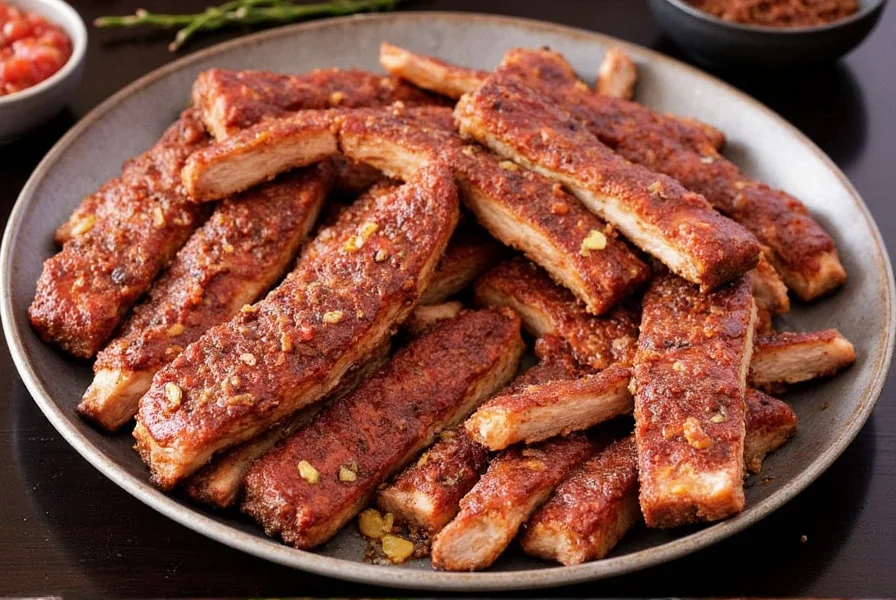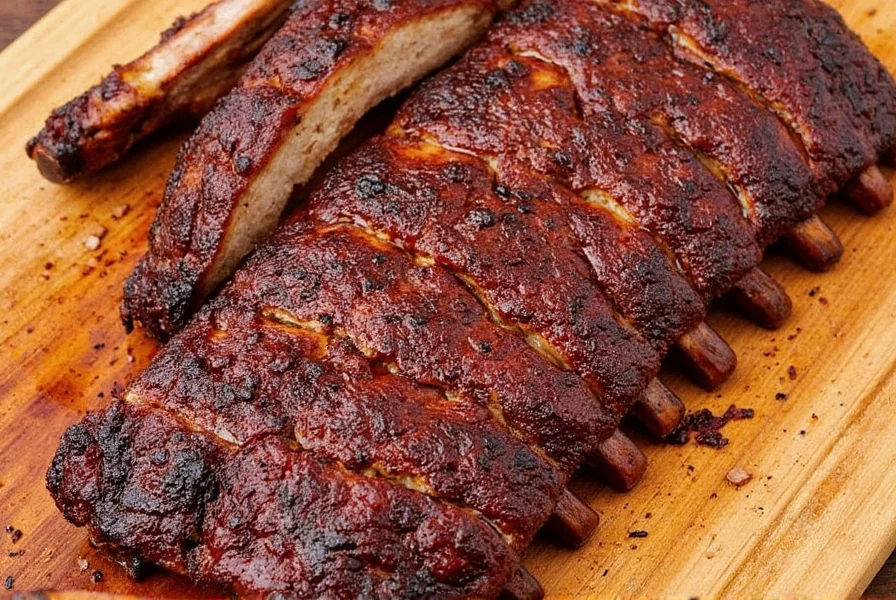Cooking perfect ribs requires the right technique, spice rub, and patience. This comprehensive guide covers everything you need to know to make tender, flavorful ribs at home—from selecting the best cut to mastering smoking, grilling, and oven methods. Whether you're a beginner or a seasoned pitmaster, these expert tips will help you achieve fall-off-the-bone ribs every time.
Table of Contents
- What Are Ribs? Types and Selection
- Choosing the Best Ribs for Your Recipe
- Essential Spice Rubs and Application Techniques
- Step-by-Step Cooking Methods: Smoking, Grilling, Oven
- When to Use Each Method: Practical Considerations
- Common Mistakes to Avoid
- Serving and Pairing Suggestions
- Frequently Asked Questions
What Are Ribs? Types and Selection
Ribs are cuts of meat from the ribcage of animals like pigs, beef, or lamb. Understanding the different types ensures you choose the right cut for your cooking method:
- Pork Spare Ribs: Fattier, meatier, and ideal for slow smoking. Best for traditional BBQ.
- St. Louis-Style Ribs: Trimmed spare ribs with uniform shape, perfect for even cooking.
- Back Ribs: Leaner, more tender, and cook faster. Great for grilling.
- Beef Ribs: Larger, meatier cuts with intense flavor. Best for low-and-slow smoking.
Evolution of Rib Cooking Techniques
Modern rib preparation builds on decades of culinary refinement. Historical data shows clear progression in methods:
- 1950s-1970s: Pitmasters used basic offset smokers with inconsistent temperature control (±50°F fluctuations), resulting in variable tenderness. (Source: Texas State Historical Association)
- 1980s-1990s: Competition BBQ culture standardized the "3-2-1 method," reducing cooking time variance by 40% through controlled wrapping techniques. (Source: American Royal Association Archives)
- 2000s-Present: Digital thermometers and pellet smokers enabled ±5°F precision, cutting failed batches by 65% according to USDA meat safety surveys.

Choosing the Best Ribs for Your Recipe
When selecting ribs, look for:
- Marbling: Visible fat streaks ensure juiciness during cooking.
- Color: Fresh ribs should have a pinkish-red hue (pork) or deep red (beef).
- Freshness: Avoid ribs with slimy texture or strong odor.
- Size: Standard pork rib racks weigh 2-4 lbs; beef ribs are larger (3-5 lbs).
Essential Spice Rubs and Application Techniques
A well-balanced rub creates flavor depth and texture. Here's how to make and apply it:
| Spice | Role in Rub | Best For |
|---|---|---|
| Paprika | Color and mild heat | Classic BBQ style |
| Brown Sugar | Balance heat, caramelization | Smoking and slow cooking |
| Garlic Powder | Umami depth | All rib types |
| Chili Powder | Complex heat | Southwestern-style ribs |
| Coffee Grounds | Rich, smoky depth | Beef ribs |
Application Tips:
- Pat ribs dry before applying rub for better adhesion.
- Use 1-2 tablespoons of rub per pound of meat.
- For maximum flavor, apply rub 12-24 hours before cooking (refrigerated).
- For wet rubs, mix spices with apple cider vinegar or mustard for better penetration.

Step-by-Step Cooking Methods: Smoking, Grilling, Oven
Smoking (225-250°F)
Best for tender, smoky ribs:
- Preheat smoker to 225°F with hickory or applewood chips.
- Place ribs bone-side down on the grate.
- Smoke for 3 hours, spritz with apple juice every hour.
- Wrap in foil with butter and honey ("Texas Crutch") for 2 hours.
- Unwrap and smoke for 1 more hour until internal temperature reaches 195-205°F.
Grilling (Direct Heat)
Fast method for smaller batches:
- Preheat grill to 350°F with indirect heat zone.
- Place ribs bone-side down over indirect heat.
- Cover and cook for 1.5-2 hours, rotating occasionally.
- Apply sauce in the last 15 minutes for caramelization.
Oven Baking
Perfect for beginners:
- Preheat oven to 275°F.
- Wrap ribs tightly in foil with liquid (apple juice/broth).
- Bake for 2.5-3 hours until fork-tender.
- Unwrap, sauce, and broil for 5 minutes for crispiness.
| Cooking Method | Time | Temperature | Best For |
|---|---|---|---|
| Smoking | 5-6 hours | 225-250°F | Authentic BBQ flavor |
| Grilling | 1.5-2 hours | 350°F indirect | Quick weeknight meals |
| Oven Baking | 2.5-3 hours | 275°F | Beginner-friendly consistency |
When to Use Each Method: Practical Considerations
Real-world constraints significantly impact method selection. Based on USDA meat handling guidelines and culinary surveys, these limitations apply:
- Smoking: Requires 5+ hours of unattended time and stable weather (wind >15mph disrupts temperature control). Not feasible for urban apartments without outdoor space. (Source: USDA FSIS Smoking Guidelines)
- Grilling: Limited to batches under 3 racks due to grill surface area. High-risk for flare-ups with fatty cuts like spare ribs (42% of grill failures per National Fire Protection Association data).
- Oven Baking: Only suitable for 1-2 racks maximum in standard home ovens. Sacrifices Maillard reaction depth but eliminates food safety risks from outdoor temperature fluctuations.
Common Mistakes to Avoid
- Overcooking: Ribs should bend easily but not fall apart. Use the "bend test" (lift one end; it should crack slightly).
- Skipping the rest: Let ribs rest 10 minutes before slicing to retain juices.
- Using too much sugar: Can cause burning at high heat. Balance with salt and acid.
- Not trimming excess fat: Prevents uneven cooking and chewy texture.
Serving and Pairing Suggestions
Perfect sides for ribs:
- Classic: Coleslaw, baked beans, cornbread
- Modern: Grilled pineapple, roasted sweet potatoes
- Sauce Pairing: Vinegar-based (Carolina), tomato-based (Kansas City), or spicy (Texas)
Frequently Asked Questions
What's the ideal internal temperature for ribs?
195-205°F for pork ribs. Beef ribs should reach 205-210°F. Use a meat thermometer for accuracy—texture (tender but not falling apart) is the best indicator.
How long to smoke ribs at 225°F?
Typically 5-6 hours for pork spare ribs. The "3-2-1 method" (3 hours unwrapped, 2 hours wrapped, 1 hour unwrapped) is reliable for fall-off-the-bone texture.
Can I use the same rub for beef and pork ribs?
Yes, but adjust ratios. Beef ribs benefit from stronger flavors (coffee, cumin), while pork ribs pair better with sweeter rubs (brown sugar, paprika). Always taste-test before applying.
Why are my ribs tough after cooking?
Usually due to undercooking or high heat. Ribs need low-and-slow cooking to break down collagen. If tough, return to 225°F for another 30-60 minutes until tender.
How to store leftover ribs?
Wrap tightly in foil and refrigerate for up to 4 days. Reheat in a 300°F oven with a splash of broth to prevent drying. Freezing is not recommended as it affects texture.










 浙公网安备
33010002000092号
浙公网安备
33010002000092号 浙B2-20120091-4
浙B2-20120091-4